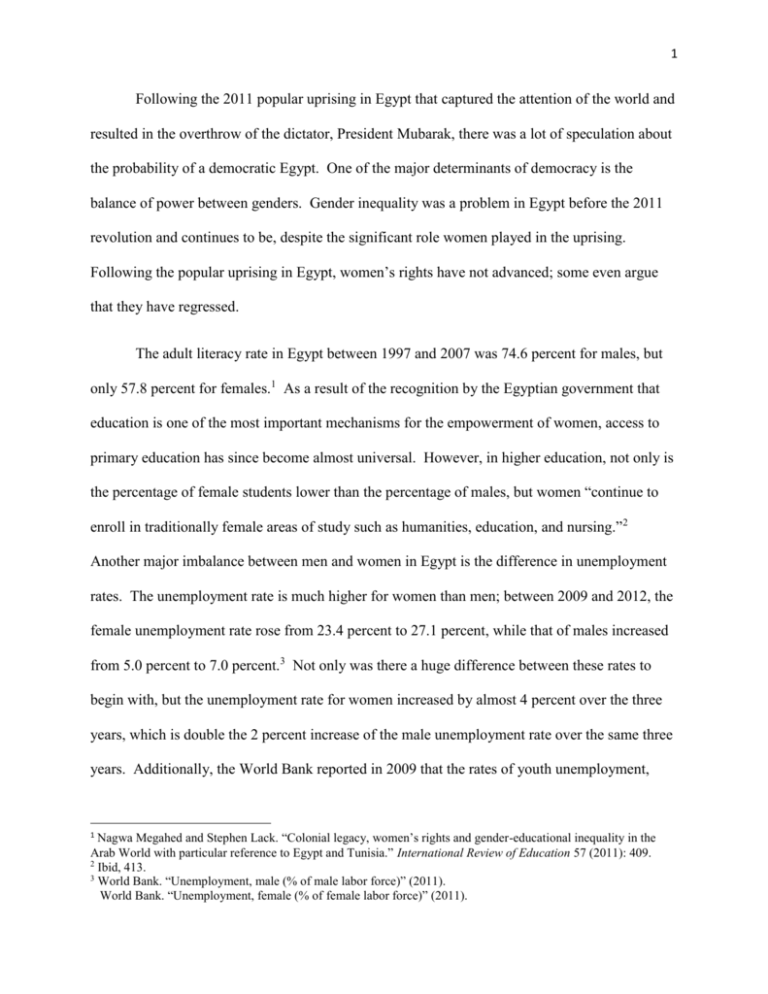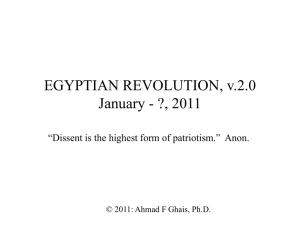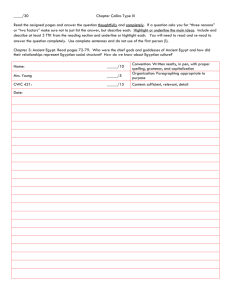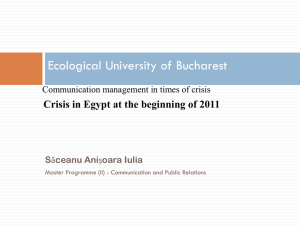Women in Egypt
advertisement

1 Following the 2011 popular uprising in Egypt that captured the attention of the world and resulted in the overthrow of the dictator, President Mubarak, there was a lot of speculation about the probability of a democratic Egypt. One of the major determinants of democracy is the balance of power between genders. Gender inequality was a problem in Egypt before the 2011 revolution and continues to be, despite the significant role women played in the uprising. Following the popular uprising in Egypt, women’s rights have not advanced; some even argue that they have regressed. The adult literacy rate in Egypt between 1997 and 2007 was 74.6 percent for males, but only 57.8 percent for females.1 As a result of the recognition by the Egyptian government that education is one of the most important mechanisms for the empowerment of women, access to primary education has since become almost universal. However, in higher education, not only is the percentage of female students lower than the percentage of males, but women “continue to enroll in traditionally female areas of study such as humanities, education, and nursing.”2 Another major imbalance between men and women in Egypt is the difference in unemployment rates. The unemployment rate is much higher for women than men; between 2009 and 2012, the female unemployment rate rose from 23.4 percent to 27.1 percent, while that of males increased from 5.0 percent to 7.0 percent.3 Not only was there a huge difference between these rates to begin with, but the unemployment rate for women increased by almost 4 percent over the three years, which is double the 2 percent increase of the male unemployment rate over the same three years. Additionally, the World Bank reported in 2009 that the rates of youth unemployment, Nagwa Megahed and Stephen Lack. “Colonial legacy, women’s rights and gender-educational inequality in the Arab World with particular reference to Egypt and Tunisia.” International Review of Education 57 (2011): 409. 2 Ibid, 413. 3 World Bank. “Unemployment, male (% of male labor force)” (2011). World Bank. “Unemployment, female (% of female labor force)” (2011). 1 2 which includes ages 15-24, in Egypt was 40 percent for females versus 21 percent for males.4 Magdi et al. found that young women in Egypt are four times as likely to be unemployed as young men.5 They also found that “the problem persists despite rising education levels” – less than 25 percent of Egyptian women report being employed within five years of graduation. 6 The disparity between genders persists today, even though women significantly impacted the popular overthrow of President Mubarak. During the 18-day uprising, “Egyptian women, previously not engaged in any activism, took their demands massively to the streets, not in the name of women emancipation, or women equality, but as an important part of the national struggle against authoritarianism.”7 Many of the women who camped inside Tahrir Square ensured the survival of the protesters; they delivered food and water and nursed wounded people.8 They also did what they could to contribute to the success of the uprising, blocking the entrances to the square and donating money, food, and their jewelry.9 Despite their significant participation in the revolution in unprecedented numbers, even at times outnumbering male participants, women were not given the credit they deserved; “malebiased accounts of the activism that instigated and sustained the revolt against the regime until Mubarak’s resignation have generally tended to ignore women’s full agency.”10 Al-Natour asserts that “the key role women played in the revolution may have shaken the social power 4 Ibid. Amin, Magdi, Ragui Assaad, Nazar al-Baharna, Kemal Dervis, Raj M. Desai, Navtej S. Dhillon, and Ahmed Galal. After the Spring: Economic Transitions in the Arab World (Oxford University Press, 2012), 40. 6 Ibid, 55. 7 Nadine Sika and Yasmin Khodary. “One Step Forward, Two Steps Back? Egyptian Women within the Confines of Authoritarianism.” Journal of International Women's Studies 13(5) (2012): 97. 8 Manal al-Natour. “The Role of Women in the Egyptian 25th January Revolution.” Journal of International Women's Studies, 13(5) (2012): 70. 9 Ibid. 10 Mariz Tadros. The Muslim Brotherhood in Contemporary Egypt: Democracy Redefined Or Confined? (Routledge, 2012), 117. 5 3 structure,” but “that key role was downplayed in the literature.”11 While the influential participation of women may have affected their social power, the revolution was not followed by any notable increase in political power. In fact, there were many negative consequences, including a backlash against women’s rights that emerged “in the form of attempts to repeal the laws pertaining to women that were introduced or amended by the Mubarak regime.”12 There are numerous examples of attacks on women’s rights following Mubarak’s resignation. Although not one case of harassment was reported from Tahrir Square during the uprising, which is surprising given Egypt’s high rate of street harassment of women, only a few days after the revolution, reports of women being harassed in Tahrir emerged.13 Additionally, according to Hafez, it was evident immediately following the uprising, when the Council of Wise Men opened negotiations with the Supreme Military Council (SMC), that “women would not be part of the political deliberations between various contending parties and the SMC in charge of the country.”14 Many Egyptians argued that a group titled the “Council of Wise Men” failed to represent both women and young people. The results of the first parliamentary elections after the overthrow of Mubarak, held in November 2011 and January 2012, delivered another blow to women’s rights. While the elections had unprecedented public turnout, they resulted in less than 2 percent representation of Al-Natour, “The Role of Women in the Egyptian 25th January Revolution.” 59. Aliaa Dawoud. “Why Women are Losing Rights in Post-Revolutionary Egypt.” Journal of International Women's Studies, 13(5) (2012): 160. 13 Sherine Hafez. “No longer a bargain: Women, masculinity, and the Egyptian uprising.” American Ethnologist 39(1) (2012): 40. 14 Ibid, 38. 11 12 4 women in both Upper and Lower Houses of Parliament and only 3 of the 26 ministries in the 2012 Ministerial Council were women.15 The biggest negative impact on women’s rights came from the Muslim Brotherhood. After the revolution, the organization laid out its plan for Egypt’s future in two documents: the FJP Election Program for the 2011 parliamentary elections and the Nahda or Renaissance Project, which became Morsi’s electoral platform in 2012.16 The Election Program “affirmed women’s rights, but with qualifications that could be understood to limit them based on Islamic and/or Egyptian cultural norms” and “called for the elimination of national rights organizations (National Council for Women and National Council for Childhood and Motherhood)” on the basis that they were “intelligence arms of international players.”17 On July 2, 2011, a conference with the theme ‘Women from the revolution to renaissance’ was organized by the newly established Sisterhood of the Brotherhood and attended by the Supreme Guide of the Muslim Brotherhood, other members of the leadership, and about 2,500 sisters.18 However, the conference “was a grand event without offering any major structural change either in relation to broadening their roles or their positioning in the Muslim Brotherhood internal organizational hierarchy.”19 In effect, the Sisterhood provides the male-dominated organization with the means to advance their mission without any intention of establishing women in meaningful leadership roles. Sika and Khodary, “One Step Forward, Two Steps Back? Egyptian Women within the Confines of Authoritarianism,” 98. 16 Jeffrey T Kenney. “The New Politics of Movement Activism: The Society of Muslim Brothers After Egypt’s Arab Spring.” Nova Religio: The Journal of Alternative and Emergent Religions 16(3) (2013): 100. 17 Ibid. 18 Tadros, The Muslim Brotherhood in Contemporary Egypt: Democracy Redefined Or Confined? 119. 19 Ibid. 15 5 Scholars have many different explanations for the lack of progress in women’s rights following the 2011 uprising. These include, but are not limited to, a sense of insecurity and emasculation felt by many young Egyptian men, a rejection of Western ideals, the resurgence of Islamic principles, and the association of women’s rights with the extremely unpopular Mubarak family. The Mubarak regime instituted a condition of dis-regulation to advance its control of the people; young men became targets of “random state violence, torture, and humiliation” and were denied education, health care, and government jobs.20 In doing so, the government instilled feelings of helplessness and dependency on the state in many Egyptians, particularly the Egyptian youth. Hafez attributes male animosity towards the empowerment of women as a result of this. He explains that “the more that men are subordinated, denied patriarchal benefits, and associated with females, the more extreme their gender differentiation from females will be. Hence, women become easily targeted victims who compensate them for their loss of patriarchal benefits and their emasculation.”21 Sika finds the same causal relationship, stating that “the dichotomy between a woman’s power and a man’s vulnerability is essential to understanding the forces at work.”22 In an ethnocentric approach, Megahed and Lack propose that the Western perception of Muslim women as victims of oppression, forced to hide behind the veil secluded from the world, have reinforced opposition to the advancement of gender equality in Egypt.23 They also believe that opposition to gender-related reforms is partly due to the resurgence of fundamentalist Hafez, “No longer a bargain: Women, masculinity, and the Egyptian uprising,” 39. Ibid, 40. 22 Nadine Sika. “The Role of Women in the Arab World: Toward a New Wave of Democratization, or an Ebbing Wave Toward Authoritarianism?” Journal of International Women's Studies 13(5) (2012): 2. 23 Megahed and Lack, “Colonial legacy, women’s rights and gender-educational inequality in the Arab World with particular reference to Egypt and Tunisia,” 414. 20 21 6 Islamic principles. Coleman also argues that “women’s rights face several challenges, including politically empowered Islamist parties that contest existing laws on religious grounds and popular inertia against increasing women’s participation in public leadership roles.”24 It has also been suggested that some of the resistance to women’s rights movements is attributed to the association of women’s rights with the Mubarak family. The former first lady, Suzanne Mubarak, was the acting president of the National Council for Women (NCW), which was established in 2000 by Presidential decree.25 Therefore, many citizens viewed it as closely affiliated with the regime. The NCW had strong legislative powers granted to it in the Egyptian Constitution, as well as a mandate that granted it the power to significantly influence laws pertaining to women; thus, the first lady, as the president of the organization, had the ability to change laws.26 In addition, over the radio and on television, men voiced their complaints that the Mubarak regime was, through this affiliation, taking away rights from men and giving them to women.27 Dawoud argues that the media’s role in linking women’s rights to the Mubaraks “led to societal dissent while the regime lasted, and after it was ousted dissent escalated into an outright backlash against women’s rights.”28 Although some observers around the world were poised for Egypt’s transition to a democracy immediately following President Mubarak’s resignation in 2011, the history of gender imbalance and the continued resistance to movement toward gender equality, caused by the combination of many factors, indicate that the democratization of Egypt is not a current reality. 24 Isobel Coleman. "Women and the Arab revolts." Brow J. World Affairs 18 (2011): 215. Dawoud, “Why Women are Losing Rights in Post-Revolutionary Egypt,” 161. 26 Ibid, 162. 27 Ibid, 166. 28 Ibid, 165. 25








